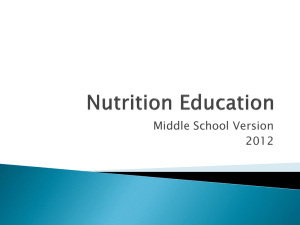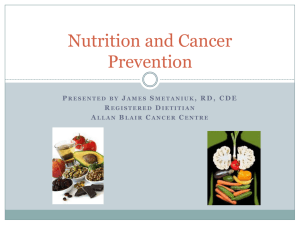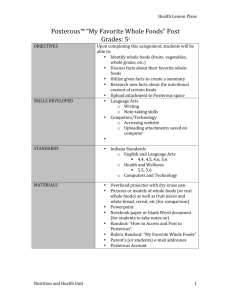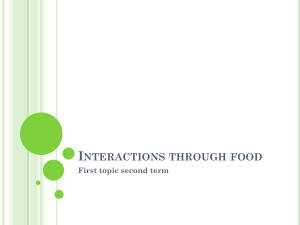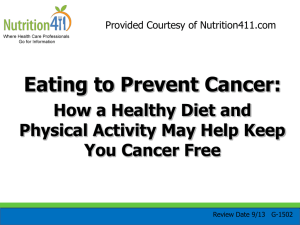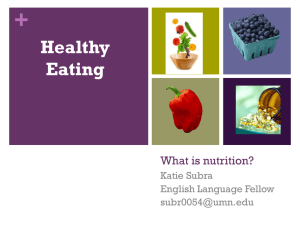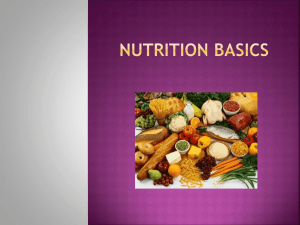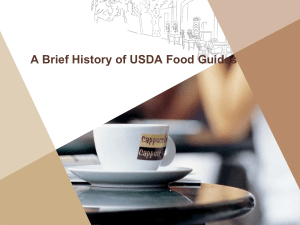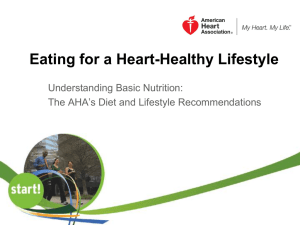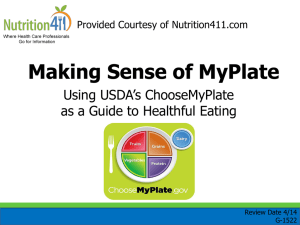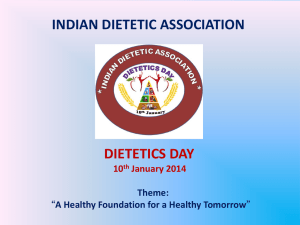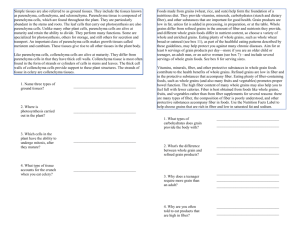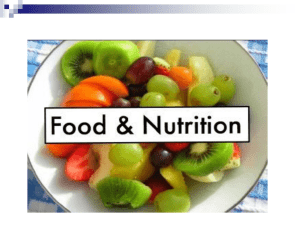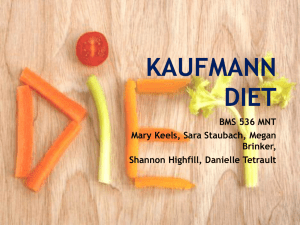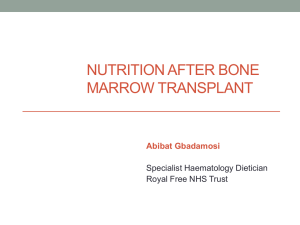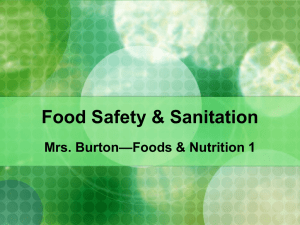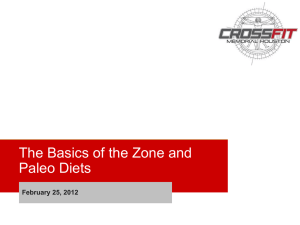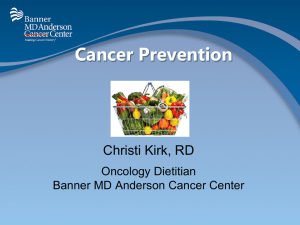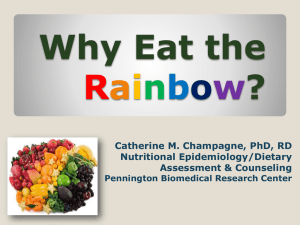MyPlate Powerpoint
advertisement
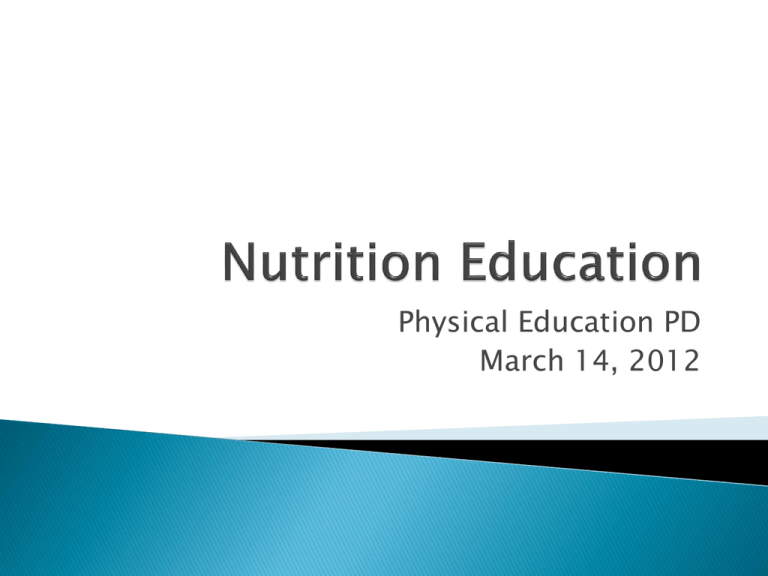
Physical Education PD March 14, 2012 What is the most serious public health issue today? 17% of children/youth ages 2-19 are obese. Food Pyramid MyPlate Fruits Vegetables Grains Proteins Dairy What are some examples of foods in this food group? Any fruit or 100% fruit juice counts as part of the Fruit Group Fruits may be fresh, canned, frozen, dried, whole, cut-up or pureed. Key Consumer Message: Make half your plate fruits and vegetables! Most fruits are naturally low in fat, sodium and calories. None have cholesterol. Fruits are sources of many essential nutrients including: potassium; dietary fiber, vitamin C, and folate. As part of a healthy diet fruit may reduce risk for heart disease, protect against certain types of cancers, reduce the risk of obesity and reduce the risk of type 2 diabetes. Student version = Fruits help heal our bodies. What are some examples of foods in this food group? Any vegetable of 100% vegetable juice counts as a member of the Vegetable Group. Vegetables may be raw or cooked; fresh, frozen, canned, or dried/dehydrated; and may be whole, cut-up, or mashed. Key Consumer Message: Make half of your plate fruits and vegetables! Most vegetables are naturally low in fat and calories. None have cholesterol. BUT SAUCES OR SEASONINGS MAY ADD FAT, CALORIES OR CHOLESTEROL!!!! Vegetables may provide dietary fiber, potassium, Vitamin A, Vitamin C and potassium. As part of an overall healthy diet, vegetables may reduce the risk for heart disease, protect against certain types of cancers and may reduce the risk of obesity and the risk of type 2 diabetes. Student version = Vegetables help our eyes see. What are some examples of foods in this food group? Any food made from wheat, rice, oats, cornmeal, barley or other cereal grains Bread, pasta, oatmeal, breakfast cereals, tortillas, and grits 2 groups: Whole Grains and Refined Grains. Key Consumer Message: Make at least half of your grains whole grains! Contain the entire grain kernel – the bran, germ, and endosperm. Examples include: whole-wheat flour; bulgur (cracked wheat); oatmeal; whole cornmeal; brown rice. Refined grains Milled – remove bran and germ Gives grains finer texture Improves shelf life Removes dietary fiber, iron and many B vitamins Examples: white flour; de-germed cornmeal; white bread; white rice. ◦ Most are enriched – vitamins and minerals added back in, but NOT dietary fiber. ◦ ◦ ◦ ◦ ◦ Dietary fiber (especially in whole grains) B vitamins Minerals – iron, magnesium and selenium Eating grains, especially whole grains as part of a healthy diet may reduce the risk of some chronic diseases: heart disease, obesity; neural tube defects during fetal development. Student version = Grains give us energy and keep our digestive system healthy. What are some examples of foods in this food group? All foods made from meat, poultry, seafood, beans and peas, eggs, processed soy products, nuts and seeds are part of the Protein Foods Group. (Beans and peas are also part of the Vegetable Group.) Select a variety of protein foods including at least 8 ounces * of cooked seafood per week. Key Consumer Message: Meat and poultry choices should be lean or low-fat. Meats, poultry, fish, dry beans and peas, eggs, nuts and seeds supply many nutrients: protein, B vitamins, vitamin E, iron, zinc, and magnesium. Omega-3 fatty acids which are found in seafood may help reduce the risk for heart disease. Proteins serve as the “building blocks” for: bones, muscles, cartilage, skin, blood, enzymes, hormones and vitamins. Proteins provide calories (energy). The nutrients in proteins serve a variety of functions in the body: they help release energy; carry oxygen in the blood; help build tissues; and many more. Student version = Proteins help build muscles in our body. All fluid milk products and many foods made from milk are part of this good group. Key Consumer message: Switch to fat-free or low-fat (1%) milk. Calcium (bones, teeth); Potassium (maintaining healthy blood pressure); Vitamin D (helps to maintain proper levels of calcium and phosphorous. In low-fat or non-fat form, provide little or no fat. Eating/drinking dairy products is linked to improved bone health – especially during childhood and adolescence. Eating/drinking dairy products may also reduce the risk of some diseases (osteoporosis; heart disease; type 2 diabetes). Student version = Dairy foods help build strong teeth and bones. Oils are fats that are liquid at room temperature. Although oils are NOT a food group, they do provide essential nutrients. Examples: canola oil; corn oil; cottonseed oil; olive oil; safflower oil. Some foods are naturally high in oils: nuts; olives; some fish; avocados. Only small amounts of oils are recommended. Increasing energy and stamina; Improving brain function; Speeding up recovery and healing processes. Assisting in many body processes. A healthful diet is... Adequate Varied Balanced Moderate An adequate diet provides enough energy, nutrients, fiber, and vitamins to support a person’s health. Variety refers to eating many different types of foods each day -- a healthful diet is not based on only one or a few types of foods. A balanced diet contains the right combinations of foods to provide the proper balance of nutrients. A healthful diet is moderate and contains the right amounts of foods for maintaining proper weight – neither too much nor too little food. Examine activities and materials at the Grade Level Stations most applicable for your work; Analyze for usability and effectiveness in P.E. setting; How might you follow-up on this lesson or activity?
